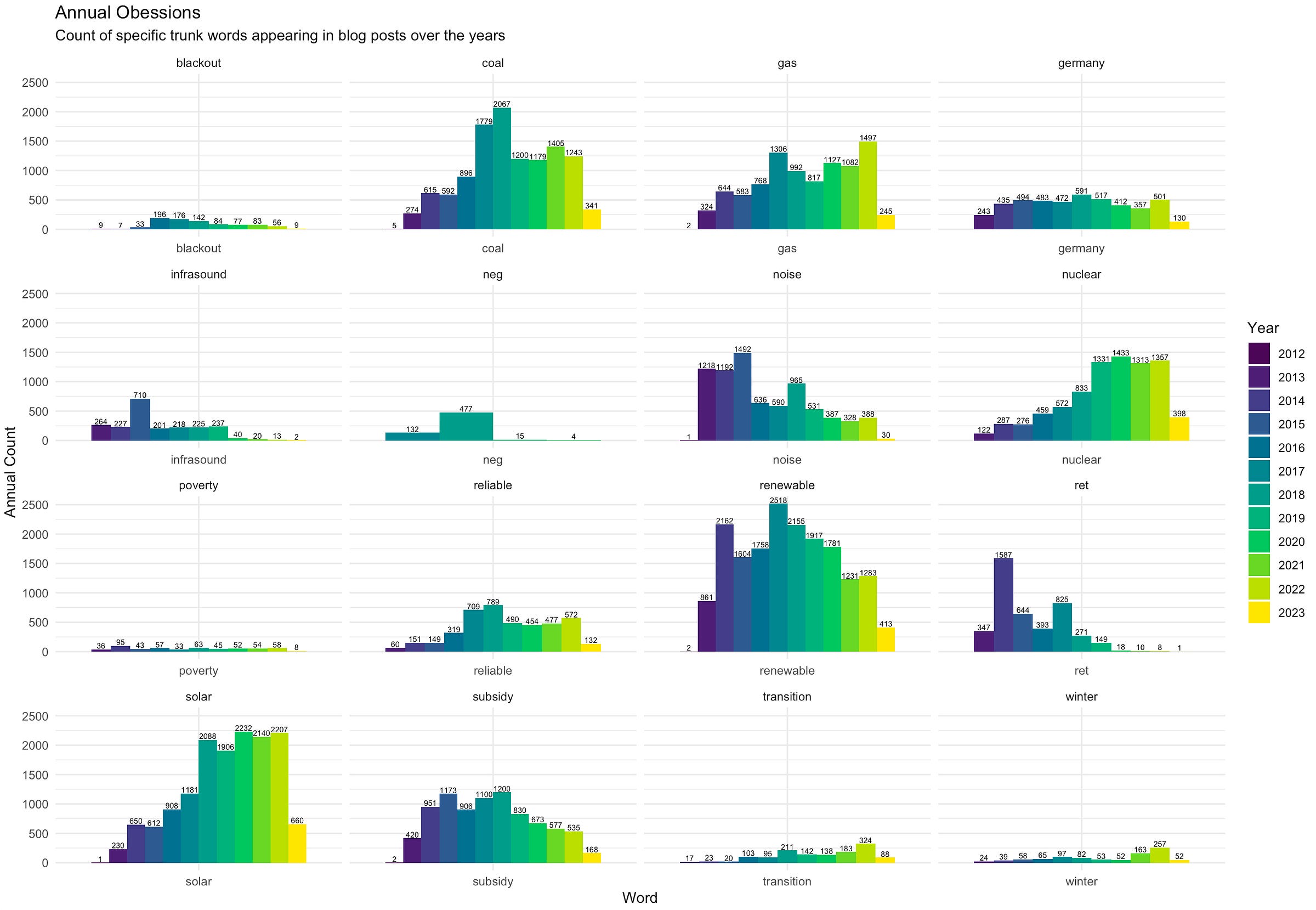
As the preeminent NEM-based Substack newsletter,1 we have an important duty to bring you the hard hitting stories about the Australian energy industry. Whether it’s discussing beefing billionaires, vague promises from the government or how to get rich by owning a natural monopoly, there’s nothing too inconsequential for us to turn our attention to.
So this week we’re rolling up our sleeves and diving into the world of angry boomers, with charts!
Stop These Things
For the longest time I’ve been fascinated by the website Stop These Things. If you’ve had the pleasure of never previously encountering it, it’s a dated and folksy Wordpress blog run by angry boomers2 with a seething and irrational hatred of wind farms. It was birthed at the height of the infrasound scare in December 2012.
They post on a daily frequency, and although there’s some original content the blog largely serves as an aggregator of other poorly written angry screeds, because these people are neither particularly clever or interesting — it’s just a big content mill with primitive SEO.3
Given it recently ticked over it’s tenth birthday, I thought I’d take the time to dive through their archives4 and explore how their neuroses have evolved or stayed the same over a decade. Join me as we explore the obsessions of the die hard climate deniers through a series of charts.
First, a quick word on why this is actually work exploring: a) it’s fun to dunk on people who write with the sophistication of an ED ad, and b) because the story of Stop These Things is the story of evolving climate change denialism. Over the last decade there’s been a subtle shift in the language used in the mainstream to deny the science and continue to delay action. Where a decade ago it might have been kosher to just come out say that you doubted anthropogenic climate change, now the debate has shifted to weaselly phrases like global elitism, energy poverty and a certain type of nuclear power advocate. And while Stop These Things still readily advocates ideas like CO2 not being a pollutant, global warming actually being a good thing and the benefits of coal-fired power; they haven’t been completely immune from the shifting sands of discourse.
While it’s easy to pass off the red-in-the-face rage of these people as comical, it’s symbolic of the communication challenges facing the industry. There’s a lot of lies and misinformation to contend with out there, and although the language keeps shifting, the underlying sentiment is the same. And yes, their website is an unmitigated bin fire, but people are still clicking through and reading.
Consistency, baby
Stop These Things is remarkably consistent.
The site began with a flurry of excitable posting, but pretty quickly settled into to a monotonous drone of daily posts. The inevitability of the energy transition appears not to have taken its toll on them, but I was surprised to see that the rage-posting hasn’t picked up since the Morrison government was unceremoniously kicked to the curb in May 2022. The only real change in posting frequency is the Christmas break each year, suggesting that maybe the blog actually is run by real humans.

Political musings
A good gauge of the preoccupations of the blog is the timing of and number of times they mention various politicians. And wow, is this graph telling.
The early years of the blog show a love affair with Abbott, Angus Taylor, and surprising only in the sense that he was a bit player senator at best, David Leyonhjelm. But in 2017 and 2018 they became obsessed with Turnbull (Prime Minister), Frydenberg (Federal Energy Minister) and Weatherill (South Australian Premier). Abbott and Taylor still featured prominently in 2017 and 2018.
Looking a little deeper into the obsession with Frydenberg and Turnbull, Stop These Things reflects a particular type of belief that although these men were conservative politicians, they weren’t conservative enough. The fact that Turnbull knifed the wind farm-hating Abbott to take the Liberal party leadership didn’t help the sentiment of his STT coverage, nor apparently did his son's investment choices.5
I was somewhat surprised to see that the right’s favourite-premier-to-hate(TM) Dan Andrews6 didn’t receive more mentions. Curiously, they do like referring to him as Daniel - no nickname for you Dan!
Recutting the analysis just slightly, to count the number of times a politician is mentioned by last name alone (and excluding some of the more common surnames) yields the following chart.
The fixation with Turnbull, Weatherill and Frydenberg is still occupying the top of the ladder, but Morrison, Taylor and Leyonhjelm and Biden have all shot up the ranks.
The frequency and timing of when politicians were called out largely reflects their time in office and their legislative actions, but politicians like Turnbull, Abbott, Rudd and Obama received significant mentions well beyond their time in office. This largely isn’t surprising given that the blog’s entire existence is predicated around a resistance to change.
Abbott and Taylor truly win the popularity award; Taylor in particular has been popular throughout the blog’s history, with a reputation as a crusader against wind turbines.
Shifting neuroses
The following chart shows the count of the top words each year over the history of the blog. Reassuringly on-brand for an anti-wind blog, wind is the top ranked word in a majority of years.
Honing our analysis a little bit to capture some specific words, we can see how the neuroses have changed over the years. Words like gas, renewable and subsidy (as well as wind, excluded from this chart) are mainstays of their conversation.
It’s interesting to look at the rise and fall of a few words:
Nuclear has really trended up in recent years, as the inevitability of coal closures has shifted the conversation to what might replace it.7
Infrasound has really dropped out of favour in recent years.
The neg (the National Energy Guarantee, Turnbull’s signature energy policy) received plenty of attention around the time of its introduction
There was a hyper obsession with the RET (the Renewable Energy Target) and how that was subsidising and fuelling the development of wind and solar farms. As renewable generation has become more cost-competitive, the focus on subsidies has also reduced.
Solar is perhaps the most interesting one to me — there’s been an increasing discussion of solar as the blog has gone on. The blog was initially anti-wind, specifically due to localised impacts, but appears to have morphed into a more general anti-renewables blog over time. Possibly simply because wind is a more mature technology, but the hatred has really ramped up in recent years.
Honourable mentions go to Winter and gas, which really peaked in 2022. Interesting to see that coal, which was a major contributor to the energy crisis in the early Australian winter last year didn’t receive as much uptick. Funny about that.
Wrapping up
We hope this dive into the annual obsessions of the climate denying complex was somewhat eye-opening.
On the one hand, we treat the energy transition as inevitable (setting aside how easy/hard you think its going to be). That makes it easy to dismiss these people as nothing more than angry boomers.
But by analysing the trends in this blog, it shows the shifting sentiments and strategies of the groups ardently opposed to the energy transition. Anti-renewable advocacy evolves and adapts with governments, global events and economics. It started by galvanising localised anti-wind vibes by focussing on things like infrasound, before going more macro and leaning more heavily into arguing climate change isn’t real. As the discourse moved on, the blog now refocussed on the need to invest in nuclear and the important role of gas.
And they’ve had significant staying power, continuing to post on a daily frequency for over a decade with much of the same passion and rage expressed in the early posts.
Ketan Joshi recently wrote about the rise of the climate deniers on Twitter, and while that analysis was focussed on the environment of the post-Musk Twitter, blogs like Stop These Things have laid a solid foundation of years of bullshit.
Think we missed some words or key points, or would you like to see a different analysis?8 Reach out in the comments below.
Things Happen
The New York Times reports that Russian gas exports are likely to be down by half relative to last year.
The ETU and AMWU are calling for a national authority to guide the energy transition.
The NSW policy of supporting new renewables and storage has announced its first big round of successful applicants. It includes over 1GW of solar, 250MW of wind and a big battery. The headlines from RenewEconomy saying “stunning low prices” have been locked in are not quite right - the successful projects have options contracts they can exercise if wholesale prices fall, effectively providing them with a floor.
Look, just because we’re the only one doesn’t mean it isn’t lonely at the top.
I can only assume they’re boomers based on their very dated website and equal love of Tony Abbott and folksy memes. I can’t actually verify this because they’re too cowardly to put their names to the trash they produce (unlike say me, who readily owns my trash).
There’s a running theme here; quite a lot of climate change denying blogs, LinkedIn third connections and closed Facebook groups operate on this same kind of unoriginal content mill. ChatGPT must be a boon for these people.
I just insulted their unsophisticated website, but it did make it a lot easier to scrape in bulk. Thanks guys.
Stop These Things has this insane running conspiracy theory about Alex Turnbull investing in [wind farm developer] Infigen being linked to Australia signing up to the Paris Agreement. It sort of plays out in the same way that American conservatives are obsessed with Hunter Biden, or really any movie with red string traced across a cork board.
Honourable mentions to Jay Weatherill and Mark McGowan, but there’s a good amount of daylight between first and second place.
The debate for nuclear in Australia does has some nuance to it, but it’s also the darling technology of a certain type of climate denier, simply because the lead time to build these stations in Australia is longer than the period that action is required in. It’s a delaying tactic.
We’d like to do a long term analysis of Twitter posts on climate topics, but under Musk the Twitter API is now only useful if you’re willing to pay a hefty sum for it. Which we’re not.









Thanks Alex, very interesting. I wonder if the people behind STT are LNP MPs. The key word analysis seems to align with their talking points.
Very cool, thanks Alex.
Most nuclear advocates I know (including myself) want genuine decarb with a low environmental footprint and we certainly don't consider it a delaying tactic! I hope my posts don't come across as being a denier!